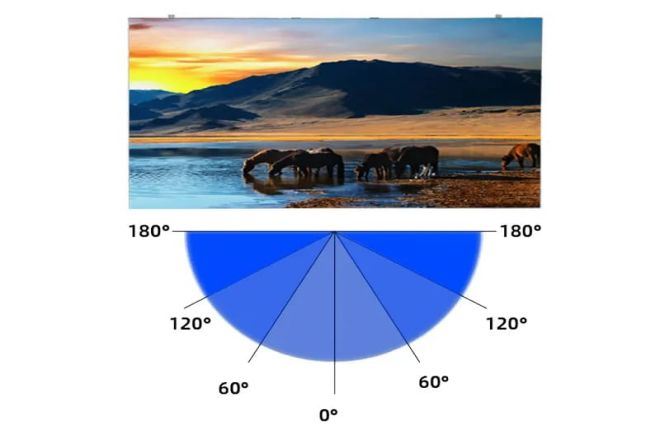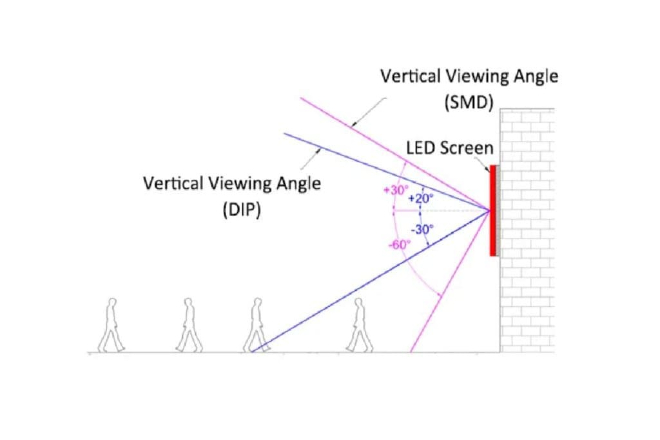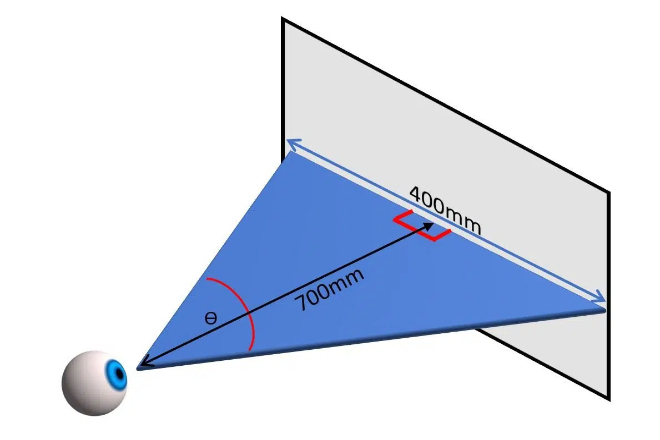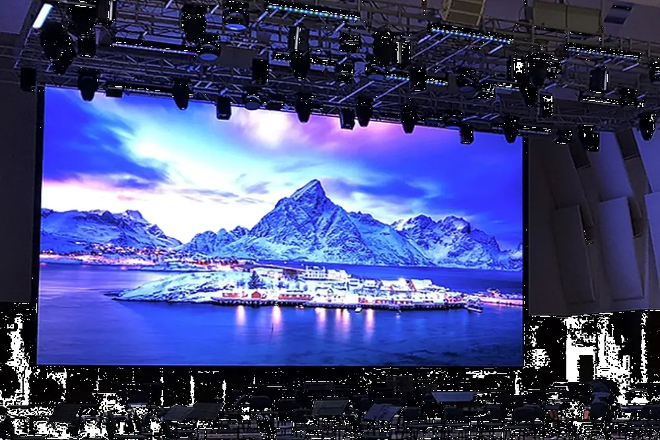介绍

In order for an LED广告屏 to fully exert its advertising effect and attract the audience’s attention, in addition to the design of the content itself, the viewing angle selection during installation is also crucial.
A poor 可视角度 may cause picture distortion and color distortion and even make it impossible for the audience to clearly see the advertising content, thereby greatly reducing the communication effect of the advertisement.
So, how to find and determine the best viewing angle to ensure that the advertising content can be presented to the audience in the best state and enhance the communication effect and commercial value of the advertisement?
目录
1. What is the best viewing angle for an LED advertising screen?
1). 可视角度:
The viewing angle is actually the angle range at which the screen can remain bright when we look at the LED advertising screen.
Imagine that you are looking at the screen, then slowly turn to the left or right, or look up and down, until the screen becomes too dark to see clearly. The angle of rotation is the viewing angle.
1.1). Horizontal viewing angle and vertical viewing angle:
The horizontal viewing angle is the angle at which you can still see the screen bright when you turn your head left or right; the vertical viewing angle is the angle at which you can still see the screen bright when you look up or down.
When measuring, just take an instrument, point it at the screen, and then slowly turn it to see when the screen becomes too dark. That angle is the viewing angle.
1.2). Viewing angle:
The viewing angle is the angle at which you can barely see what is on the screen. At this angle, although the screen may not be so bright, you can still see it roughly.
1.3). Optimal viewing angle:
The optimal viewing angle is the angle at which you can see the screen most clearly, and the color is most accurate. At this angle, the screen looks like it is right in front of you, very real.
2). Measuring method of horizontal viewing angle and vertical viewing angle
In fact, it is quite simple to measure horizontal viewing angles and vertical viewing angles.
Just take a brightness meter or something, point it at the screen, and slowly turn it. In the beginning, the screen must be very bright, and then you turn it around, and the screen slowly becomes darker.
When you turn to a certain angle, the screen brightness becomes half of the original, or the contrast drops to a certain level (such as 10:1), and that angle is the viewing angle.
The horizontal viewing angle is measured when turning left and right, and the vertical viewing angle is measured when turning up and down.
3). Interpretation of viewing angle parameters
3.1). The meaning of viewing angle parameters (such as 160°/140°) provided by LED display manufacturers:
For example, the manufacturer says that their screen viewing angle is 160°/140°, which means that as long as you turn your head left or right and it does not exceed 80° (because 160° is 80° on one side plus 80° on the other side), the screen is still quite bright.
You look up or down, as long as it does not exceed 70° (because 140° is 70° on one side plus 70° on the other side), the screen can still be seen clearly.
3.2). The impact of viewing angle on the audience’s viewing effect:
- The larger the viewing angle, the wider the viewing range:
The advantage of a larger viewing angle is that more people can see the screen at the same time. For example, if you stand across the street, you can also see clearly what is on the advertising screen across the street, so the advertising effect will be better.
- The trade-off between viewing angle and 亮度:
However, there is also a problem with a larger viewing angle, that is, the screen may become less bright. Because the light has to be scattered over a larger range, there is less light in each place.
So when choosing a screen, you have to see if the brightness is enough. Don’t choose a screen that is too dark to see clearly just for a wide viewing angle.
- Difference in viewing effect:
When you look at the screen at the best viewing angle, the feeling is different. The colours are particularly bright, and the images are particularly clear, just like looking at the real thing.
But if you exceed the best viewing angle, the screen may become a little blurry, and the colours may not be accurate. So, when looking at the screen, you still have to find a good angle.
In general, when choosing an LED advertising screen, you have to consider factors such as viewing angle, brightness, and resolution.
A wide viewing angle is good, but the brightness must be enough; a high resolution is clear, but the price may also be high. So you still have to choose according to your needs and budget.
2. What are the factors that affect the viewing angle of LED advertising screens?

1). LED chip packaging method
1.1). The impact of different packaging methods on viewing angle:
SMD packaging is like sticking a bunch of small LED lamp beads tightly on a board. The resulting display has a high pixel density and looks particularly clear.
Moreover, its viewing angle is quite wide, about 140°, and you can see the content on the screen clearly even if you stand next to it.
DIP packaging is to directly insert the LED lamp beads into the board. The viewing angle of the display screen made in this way is relatively narrow, about only 100-110°.
Moreover, it is more troublesome to produce and the efficiency is not high.
COB packaging is even more powerful. It directly encapsulates the LED chip on the board without the protruding part of the lamp bead, so the viewing angle is particularly wide, reaching 160° or even more.
Moreover, its brightness is also very high, especially suitable for outdoor use.
1.2). Advantages and disadvantages and applicable scenarios:
- SMD packaging:
The advantage is wide viewing angle and high clarity, which is suitable for occasions that require a high-definition display, such as high-end commercial advertisements, indoor exhibitions, etc. The disadvantage is that the cost may be a bit high.
- DIP封装:
The advantage is a mature technology and low cost, which is suitable for occasions that do not require high viewing angles but care more about cost, such as some simple signs and logos.
- COB封装:
The advantages are ultra-wide viewing angle and ultra-high brightness, which is especially suitable for outdoor advertising screens and stage background screens that require wide viewing angles and high brightness.
The disadvantages are that the cost and technical difficulty are relatively high.
2). Display module and manufacturing process
High-quality display modules and fine manufacturing processes are like putting on a custom-made piece of clothing for the LED advertising screen, making it look perfect.
A good display module means more uniform pixels and better display effects. Fine manufacturing processes can reduce light scattering and reflection, making the viewing angle larger.
3). Pixel density and lamp bead arrangement
3.1). The effect of pixel density on viewing angle:
Pixel density is like the small dots on the screen. The more dots there are, the clearer the picture.
However, too many dots are not good either, because the distance between the dots becomes smaller, and light is easily scattered and reflected between the dots, affecting the viewing angle. Therefore, the pixel density should be moderate.
3.2). The effect of lamp bead arrangement on viewing angle and display effect:
The arrangement of lamp beads is also very important. If the arrangement is reasonable, the scattering and reflection of light can be reduced, making the contrast and clarity of the display screen higher.
Moreover, different arrangements will affect the viewing angle. Therefore, manufacturers must carefully consider these factors when designing.
4). Ambient lighting conditions
The light intensity of the outdoor environment is a big problem. If the light is too strong, the display screen will appear very dark and unclear. Moreover, strong light will reduce the contrast of the display screen and make the picture blurry.
In addition, the light intensity will also affect the viewing angle. Therefore, when using LED advertising screens outdoors, we must consider the factor of light intensity.
In order to improve the viewing angle and brightness performance of outdoor LED advertising screens, we can take some sun protection measures. For example, install a sunshade on the surface of the display screen or apply a layer of anti-reflective coating or something.
In this way, the impact of light on the display screen can be reduced. In addition, the brightness setting of the display screen can be automatically adjusted according to the ambient light intensity.
For example, adjust the brightness a little higher in strong light and adjust the brightness a little lower in weak light, which can save energy and ensure the viewing effect.
3. What is the impact of the installation position and viewing distance of the LED advertising screen on the viewing angle?

1). Installation position selection
1.1). The impact of different installation positions on the viewing angle:
- 墙壁安装:
Installing the LED advertising screen on the wall can provide the audience with a more direct and clear viewing experience. Wall installation is usually suitable for places with limited indoor or outdoor space, such as commercial blocks, 购物广场, ETC。
In this installation method, the viewing angle mainly depends on the size of the display and the distance between the audience and the screen.
If the installation position is high, the audience needs to look up to watch, which may affect the viewing comfort; if the installation position is too low, it may limit the audience’s viewing range.
- Column installation:
Column installation is usually used in places with large outdoor spaces, such as squares, stations, etc. In this installation method, the LED advertising screen can be placed independently, with a better field of view and independence.
Column installation can flexibly adjust the height and angle of the display to meet the viewing needs of different audiences. However, the cost of column installation is relatively high, and the stability and safety of the column need to be considered.
- Roof installation:
Roof installation is usually used in places that need to attract long-distance attention, such as the exterior walls of high-rise buildings, bridges or advertising towers.
In this installation method, LED advertising screens can expand the field of view and attract audiences from farther away.
However, rooftop installation needs to consider factors such as the load-bearing capacity, windproof performance and installation difficulty of the roof.
1.2). How to choose a suitable installation location according to the installation environment:
When choosing an installation location, it is necessary to comprehensively consider factors such as the number of viewers, viewing distance, viewing angle, environmental factors (such as light, temperature, humidity, etc.) and cost budget.
For example, in commercial blocks or shopping malls, wall installation may be a more appropriate choice.
In places with large outdoor spaces, such as squares or stations, column installation may be more appropriate; and in places that need to attract long-distance attention, such as the exterior walls of high-rise buildings, rooftop installation may be more appropriate.
2). Viewing distance calculation and adjustment
2.1). Method for calculating the best viewing distance by dot pitch:
The dot pitch of the LED display (that is, the distance between two adjacent pixels) is one of the key factors in determining the best viewing distance.
Generally speaking, the best viewing distance can be estimated by multiplying the dot pitch by a coefficient (usually between 1000 and 3000).
For example, for an LED display with a dot pitch of 2 mm (P2), the optimal viewing distance is roughly between 2 meters and 6 meters.
2.2). The importance of adjusting screen specifications and installation angles according to the audience’s viewing distance:
In the actual installation process, it is necessary to select appropriate screen specifications and installation angles according to the audience’s viewing distance.
If the audience is far away from the screen, it is necessary to select a screen with a larger dot pitch and a larger size to ensure that the audience can clearly see the screen content.
At the same time, it is also necessary to adjust the installation angle of the screen to meet the audience’s viewing needs.
For example, in outdoor advertising, if the audience is mainly distributed on both sides of the road, the installation angle of the screen needs to be adjusted to tilt to both sides so that the audience can better view the screen content.
In addition, the impact of environmental factors on the viewing distance also needs to be considered.
For example, in a strong light environment, in order to maintain the viewing effect, it may be necessary to appropriately shorten the viewing distance or increase the brightness of the screen.
In a weak light environment, the viewing distance can be appropriately extended or the brightness of the screen can be reduced to save energy.
In summary, the installation position and viewing distance of the LED advertising screen have a direct impact on the viewing angle.
When choosing an installation location and calculating viewing distance, multiple factors need to be considered to ensure that viewers can get the best viewing experience.
4. How to find the best viewing angle for LED advertising screens?
1). Preliminary measurement and planning
Before installing the LED advertising screen, we must first do a “full body check” of the installation environment, that is, preliminary measurement and planning. This step is very important, as it determines where, how, and how high the screen is installed.
- Measuring the environment:
You need to use a ruler to measure how big the installation area is and what shape it is, and then see if there are any obstacles around, such as big trees, tall buildings, etc., which may affect everyone’s viewing of the screen.
- Planning the location:
After measuring, you have to think about where the screen is most suitable to be installed. Generally speaking, you have to choose a place with a large flow of people and where everyone’s eyes are easily focused.
- Determine the angle and height:
You also have to think about how much the screen should be tilted and how high it should be installed. This depends on everyone’s usual viewing habits, and you have to ensure that everyone can see the content on the screen clearly.
2). Adjust the screen angle and height
After the screen is installed, don’t think that it’s done. You still have to adjust the angle and height of the screen according to the actual viewing position and distance.
- Observe the viewing angle:
Don’t rush to install it. Look at the screen from different positions to see if everyone has to look up or down when watching. If so, you need to adjust it.
- Adjust the angle:
According to the results, tilt the screen so that everyone’s eyes are almost level with the screen or slightly lower so that it is most comfortable to watch.
- Adjust the height:
Also, check whether the screen is installed high. If it is too high, everyone has to look up to see it, and if it is too low, it may be blocked. You have to adjust the height to a suitable level so that everyone can watch comfortably.
3). On-site testing and adjustment
Don’t rush to celebrate after the adjustment. You have to do an on-site test to see the actual effect.
- Invite audience testing:
Find some people, let them look at the screen from different positions, and then ask them how they feel. In this way, you can know where the screen looks good and where you need to change it.
- Observe the viewing effect:
You also have to take a close look to see if the content on the screen is clear, whether the color is good, and what the contrast is. If you feel uncomfortable watching any part, it may be that the angle or height of the screen is not adjusted properly.
- Fine-tune the angle and height:
According to the test results, slightly adjust the angle and height of the screen. This may take several attempts until you find the angle and height that everyone is most comfortable watching.
说起来,要找到LED广告屏的最佳观看角度并不是一件容易的事,要测量、要规划,安装后还要调整,最后还要到现场测试。
不过,只要我们有耐心,一步步来,就一定能找到让大家观看最舒服的角度和高度,这样我们的广告屏才能发挥最大的效果!
5. 在不同场景下寻找最佳观看角度的策略

1). 室内场景
在室内,大家观看LED广告屏的习惯和站立姿势都挺有意思的,比如在商场里,大家可能喜欢在扶梯边、中庭或者店铺门口凑热闹。
会议室里,大家都有秩序地坐在自己的座位上,这些位置都是人流量大,或者视线特别好的地方。
- 初步规划:
我们需要先看室内布局,思考观众的走动方式,然后确定大概的安装位置和角度,确保屏幕能够覆盖大多数人,并且不被任何东西遮挡。
- 现场测量:
安装前需要用尺子测量一下,看看屏幕应该安装多高,倾斜多少度。也可以找几个人模拟一下,听听他们怎么说。
- 微调角度:
安装完成后不要急着离开,需要再看一眼。根据现场情况和反馈,稍微调整一下屏幕的角度,让大家观看起来更舒服。
- 光照适应:
室内光线不同,屏幕也要相应调整,太亮就要调暗,太暗就要调亮,保证大家都能看清楚。
2). 户外场景
户外环境则复杂得多,需要考虑阳光、风、温度、湿度等因素,如果阳光太强,屏幕可能会反光。
如果风太大,屏幕可能会抖动;如果温度和湿度发生变化,屏幕可能会出现问题。
- 选址考虑:
安装屏幕的位置必须选择好,避免阳光直射,也不要风太大。例如,建筑物侧面或遮阳棚下都是不错的选择。
- 防水设计:
户外雨水较多,屏幕必须防水。确保屏幕不进雨水,才能保证屏幕的长期使用。
- 防风加固:
强风时,屏幕必须保持稳定,因此必须进行加固。使用坚固的支架和电缆,防止屏幕被风吹倒。
- 防震措施:
在地震多发地区,还必须考虑防震措施。采用防震技术安装屏幕,确保屏幕在地震期间稳定。
- 角度调整:
户外环境多变,屏幕的角度和高度也需相应调整,确保在不同的光线和天气下,每个人都能清晰观看。
3). 特殊场景(如交通枢纽、商业街区等)
交通枢纽、商业区等地方,人来人往,观看习惯也各有不同。
有些人匆匆走过,有些人驻足观看,如何吸引大家的注意力,又让内容快速传达,你必须仔细思考。
- 显著位置:
安装屏幕的位置一定要显眼,可以是人多、视线好的地方。比如车站入口,或者商业区的中心广场。
- 动态内容:
内容必须动感十足,引人入胜。动画、视频等都可以,这样大家第一眼就能被吸引。
- 亮度 调整:
户外光线变化较大,屏幕亮度也要相应调整,如果阳光强烈,还要调整亮斑,保证大家都能看清楚。
- 多角度安装:
如果条件允许,屏幕可以多角度安装,这样可以覆盖更多的观众,让每个人都能从不同的方向观看。
- 交互元素:
增加一些互动元素也挺有意思的,比如触摸屏、扫码互动等等,这样大家都能参与进来,更有趣。
总体来说,不同场景下最佳的观看角度搜索策略需要考虑很多因素,受众习惯、环境因素、内容传播效果等都要考虑。
只有通过合理的规划、测量、调整、设计,LED广告屏才能在不同的场景下发挥出最佳的宣传效果,我们要用心去做,才能让受众喜欢我们的屏幕!
6、LED广告屏视角未来趋势及展望
1). 技术发展趋势
1.1). 提高可视角度的未来趋势:
你知道吗?未来LED显示屏的可视角度将迎来大变革!虽然目前的LED屏幕拥有良好的可视角度,但未来的技术将使可视角度更宽广、更均匀。
无论你站在哪里,都可以清晰地看到屏幕上的内容,就像身临其境一样。
1.2). 新技术对可视角度的影响:
说到新技术,Micro LED 和 Mini LED 绝对是最热门的!Micro LED 拥有极小的像素、高分辨率和超强的对比度。
最重要的是,它的视角几乎可以达到180度,所以无论你站在哪里都可以清楚地看到它。
至于Mini LED,它的背光分区更多,亮度和对比度也更出色,可视角度也还不错,可以满足大多数场景。
2). 市场需求变化
2.1). 广告市场的新要求:
现在的广告市场变化很快!客户对LED广告屏的视角要求越来越高,希望屏幕能够覆盖更多的人群,提高广告曝光率。
同时,他们也希望屏幕显示效果能够更加逼真,更加吸引人,毕竟现在的观众非常挑剔,丑陋的广告他们不会多看一眼。
2.2).适应市场需求,提高竞争力:
为了跟上市场的步伐,LED广告屏厂家必须更加努力!他们必须不断研发新技术,提高产品的视角性能和显示效果。
还必须根据客户需求定制专属的广告屏,满足客户挑剔的眼光,提升产品的竞争力。
其实,厂商可以多做市场调研,了解客户真正想要什么,然后根据这些需求,开发新技术、新产品,这样既能满足客户需求,又能促进产品畅销。
七、结论
从以上文章我们不难看出,最佳观看角度对于LED广告屏来说其实非常重要,它对于提升广告效果,吸引观众注意力,都有一定的影响。
展望未来,随着LED显示技术的不断发展和市场需求的变化,我们相信在提高视角方面将会有更多的创新和突破,为LED广告屏的广泛应用提供更有力的支持。
最后,如果您想了解更多关于LED显示屏的知识, 请与我们联系。
